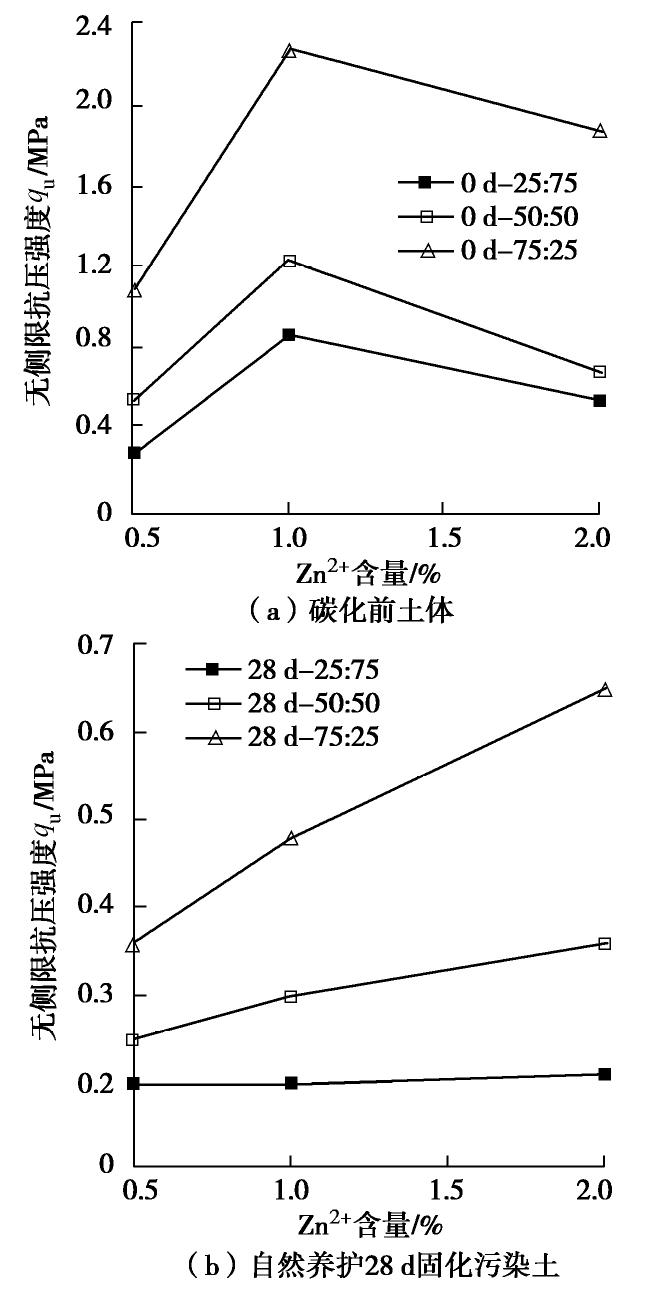Strength and electrical conductivity characteristics of zinc contaminated soil carbonated/stabilized with GGBS-reactive MgO
-
摘要: 采用工业废弃物粒化高炉矿渣(GGBS)-活性氧化镁(MgO)复合固化剂对锌(Zn)污染土进行碳化/稳定化处理,开展了碳化/稳定化Zn污染土的无侧限抗压试验和电导率测试试验,并与自然养护28 d的未碳化Zn污染土进行对比。研究了Zn2+浓度、固化剂掺和比对碳化/稳定化Zn污染土的无侧限抗压强度(qu)和孔隙液电导率特性的影响规律。试验结果表明:①当固化剂掺和比一定时,碳化固化Zn污染土的qu随Zn2+浓度的增加呈现先上升后降低趋势,而电导率呈持续上升趋势;②当Zn2+浓度一定时,碳化固化土的qu随复合固化剂中活性MgO含量的提高而上升,但其电导率却略有下降;③与自然养护28 d的未碳化Zn污染土相比,碳化后Zn污染土的qu更高,但电导率几乎不变。研究成果为工业废弃物和二氧化碳的再利用及其在重金属Zn污染土的绿色处理提供了新途径,对加速“碳达峰”具有重要的理论意义。Abstract: In this study, the compound binder of ground granulated blast furnace slag (GGBS)-reactive MgO is used for the carbonization/stabilization treatment of zinc (Zn)-contaminated soil. The unconfined compression and electrical conductivity tests on the carbonated/stabilized Zn-contaminated soil are conducted, and the uncarbonated Zn-contaminated soil after 28-day standard curing is used for comparison. The effects of Zn-ion concentration and binder mixing ratio on the unconfined compressive strength (qu) of the carbonated/stabilized soils and the conductivity of the pore fluid are investigated. The test results indicate that: (1) When the mixing ratio of curing agent is fixed, the qu of the carbonated Zn- contaminated soil first increases and then decreases with the increase of Zn ion concentration, while the conductivity increases. (2) When the content of Zn-ion concentration is fixed, the qu of the carbonated Zn-contaminated soil increases with the increase of reactive MgO content in the binder, but its conductivity decreases slightly. (3) The qu of the carbonated zinc contaminated soil is higher compared with that of the noncarbonated Zn- contaminated soil (28-day standard curing), but the conductivity is almost the same. This study will provide a new approach for the reuse of industrial wastes and carbon dioxide as well as the low-carbon treatment of Zn-contaminated soil, and be of important significance for accelerating the "carbon peak".
-
-
表 1 试验土样的物理化学指标
Table 1 Physical and chemical indexes of soil samples
天然含水率/% 液限/% 塑限/% 最优含水率/% 最大干密度/(g·cm-3) 相对质量密度 pH值 26.1 33.8 22.9 14.2 1.64 2.71 8.78 表 2 不同条件影响下的试验方案
Table 2 Test schemes under different conditions
编号 重金属离子浓度/% 固化掺合比 是否碳化 0d-25:75 0.5/1.0/2.0 25∶75 √ 0d-50:50 0.5/1.0/2.0 50∶50 √ 0d-75:25 0.5/1.0/2.0 75∶25 √ 28d-25:75 0.5/1.0/2.0 25∶75 × 28d-50:50 0.5/1.0/2.0 50∶50 × 28d-75:25 0.5/1.0/2.0 75∶25 × -
[1] CHEN Q Y, TYRER M, HILLS C D, et al. Immobilisation of heavy metal in cement-based solidification/ stabilisation: a review[J]. Waste Management, 2009, 29(1): 390-403. doi: 10.1016/j.wasman.2008.01.019
[2] VOGLAR G E, LEŠTAN D. Solidification/stabilisation of metals contaminated industrial soil from former Zn smelter in Celje, Slovenia, using cement as a hydraulic binder[J]. Journal of Hazardous Materials, 2010, 178(1/2/3): 926-933.
[3] LIU J J, ZHA F S, XU L, et al. Strength and microstructure characteristics of cement-soda residue solidified/ stabilized zinc contaminated soil subjected to freezing- thawing cycles[J]. Cold Regions Science and Technology, 2020, 172: 102992. doi: 10.1016/j.coldregions.2020.102992
[4] 曹菁菁. 活性氧化镁碳化固化土微观机理及应用研究[D]. 南京: 东南大学, 2016. CAO Jing-jing. The Application and Micro-mechanism of Carbonated Reactive Magnesia Solidified Soils[D]. Nanjing: Southeast University, 2016. (in Chinese)
[5] 陈金洪, 贺瑶瑶, 胡亚风. 粒化高炉矿渣-氧化镁固化连云港软土的力学特性试验[J]. 林业工程学报, 2019, 4(2): 133-138. https://www.cnki.com.cn/Article/CJFDTOTAL-LKKF201902022.htm CHEN Jin-hong, HE Yao-yao, HU Ya-feng. Experimental study of mechanical and microstructural properties of Lianyungang soft soil solidified by granulated blast-furnace slag-magnesium oxide[J]. Journal of Forestry Engineering, 2019, 4(2): 133-138. (in Chinese) https://www.cnki.com.cn/Article/CJFDTOTAL-LKKF201902022.htm
[6] YI Y L, LISKA M, AL-TABBAA A. Properties and microstructure of GGBS-magnesia pastes[J]. Advances in Cement Research, 2014, 26(2): 114-122. doi: 10.1680/adcr.13.00005
[7] DU Y J, BO Y L, JIN F, et al. Durability of reactive magnesia-activated slag-stabilized low plasticity clay subjected to drying-wetting cycle[J]. European Journal of Environmental and Civil Engineering, 2016, 20(2): 215-230. doi: 10.1080/19648189.2015.1030088
[8] CAI G H, LIU S Y, DU Y J, et al. Strength and deformation characteristics of carbonated reactive magnesia treated silt soil[J]. Journal of Central South University, 2015, 22(5): 1859-1868. doi: 10.1007/s11771-015-2705-5
[9] 刘松玉, 曹菁菁, 蔡光华. 活性氧化镁碳化固化粉质黏土微观机制[J]. 岩土力学, 2018, 39(5): 1543-1563. https://www.cnki.com.cn/Article/CJFDTOTAL-YTLX201805001.htm LIU Song-yu, CAO Jing-jing, CAI Guang-hua. Micromechanism of carbonation and solidification of silty clay with activated magnesium oxide[J]. Rock and Soil Mechanics, 2018, 39(5): 1543-1552, 1563. (in Chinese) https://www.cnki.com.cn/Article/CJFDTOTAL-YTLX201805001.htm
[10] YI Y L, LISKA M, AL-TABBAA A. Properties of two model soils stabilized with different blends and contents of GGBS, MgO, lime, and PC[J]. Journal of Materials in Civil Engineering, 2014, 26(2): 267-274. doi: 10.1061/(ASCE)MT.1943-5533.0000806
[11] 薄煜琳. 粒化高炉矿渣和氧化镁固化稳定化铅污染黏土的强度、溶出及微观特性的研究[D]. 南京: 东南大学, 2015. BO Yu-lin. The Strength, Leaching and Microscopic Mechanism of Ground Granulated Bast Furnace Slag and Magnesium Oxide Stabilized Lead-Contaminated Soils[D]. Nanjing: Southeast University, 2015. (in Chinese)




 下载:
下载:






